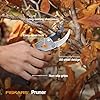Bonsai Tree Kit, Bonsai Starter Kit with Seeds & Tools, Tree Live Plants Indoor, Gardening Gifts for Women Men Mom Father Plant Lover, Birthday Thanksgiving
10% OffFiskars Bypass Pruning Shears, 5/8-Inch Cut Capacity Garden Clippers, Gardening Scissors with Sharp, Rust Resistant Steel Blade
7% OffKeeping Your Furry Friends Safe: 15 Non-Toxic Indoor Plants for Homes with Pets
Bringing plants into your home can help purify the air, add warmth, and create a more aesthetically pleasing environment. However, many common houseplants can be toxic to pets if ingested. Dogs and cats often chew on or ingest plants out of boredom, curiosity, or to induce vomiting.
As pet owners, we want to ensure our furry friends remain safe and healthy. The good news is there are many non-toxic indoor plants perfectly safe to have around dogs, cats, and other household pets.
In this comprehensive guide, we’ll cover the following topics:
Contents:
- Why Indoor Plants Are Beneficial
- Dangers of Toxic Plants for Pets
- How to Pet-Proof Your Plants
- 15 Non-Toxic Indoor Plants Safe for Pets
- Snake Plant
- Prayer Plant
- Spider Plant
- Pothos
- Ponytail Palm
- Parlor Palm
- Peperomia
- Succulents
- Boston Fern
- Peacock Plant
- Polka Dot Plant
- Orchid
- Air Plants
- Cast Iron Plant
- Dracaena
- Signs of Plant Poisoning in Pets
- First Aid for Plant Poisoning
- Final Tips for Pet Safety with Plants
Why Indoor Plants Are Beneficial
Fill your home with indoor plants and you’ll reap many benefits beyond simple decoration. Houseplants help create a more aesthetically pleasing and comfortable environment. Additional advantages include:
- Improve air quality – Plants absorb CO2 and release oxygen through photosynthesis. NASA studies show houseplants can significantly decrease toxins like benzene, formaldehyde, and trichloroethylene from the air.
- Increase humidity – Most indoor environments have dry air. Plants add moisture to the air through transpiration. This can help ease health issues like dry skin, throat irritations, and colds.
- Reduce stress and increase happiness – Studies show being around plants can lower stress, increase productivity, and boost moods. The color green itself has a calming effect.
- Remove odors – Plants like aloe, garden mum, and spider plants help absorb and remove odors. They can improve air quality and create a fresher indoor environment.
- Provide temperature insulation – Strategically placing plants helps insulate rooms from temperature extremes or fluctuations. This can reduce energy costs for heating and cooling.
- Improve acoustics – Plants absorb, reflect, and scatter sound waves, helping reduce noise pollution indoors. More plants = less echo and louder ambient noises.
Getting these rewards does require choosing safe, pet-friendly plants suited for your home. Let’s look at potential dangers and how to minimize risks.
Dangers of Toxic Plants for Pets
Many common houseplants contain substances that can cause illness or injury if eaten. Dogs and cats often chew leaves or stems out of curiosity or boredom. Toxicity levels vary between plant species and the size of the pet. Small dogs or cats are at higher risk.
Here are some problems that may result from a pet ingesting a toxic plant:
- Oral irritation – Mouth pain, drooling, tongue swelling
- Vomiting, diarrhea – Dehydration can quickly become life-threatening
- Internal organ damage – To the liver, kidney, heart muscles, etc.
- Respiratory distress – Trouble breathing if airways swell
- Skin irritation – Rashes, itching, allergic reactions
- Behavioral changes – Depression, disorientation, seizures
While most cases result in mild symptoms, some plants can cause catastrophic organ failure, coma, and even death. Quick action is essential if you witness or suspect plant poisoning. We’ll cover first aid steps later in this guide.
Below are a few of the most toxic indoor plants for dogs and cats:
| Toxic Plants | Toxic Parts | Symptoms |
|---|---|---|
| Lilies | Leaves, flowers, pollen | Kidney failure |
| Sago Palm | All parts, especially seeds | Vomiting, liver failure |
| Oleander | All parts, especially leaves | Heart problems, tremors |
| Chrysanthemums | Stems, leaves, flowers | Drooling, dermatitis |
| Azaleas | All parts | Vomiting, diarrhea, weakness |
| Daffodils | Bulbs | Vomiting, convulsions |
| Marijuana | Leaves, stems, seeds | Depression, hypothermia |
| Aloe | Leaves | Vomiting, diarrhea |
| Rhododendrons | All parts | Reduced heart rate, difficulty breathing |
How to Pet-Proof Your Plants

While the completely fail-safe approach is to avoid plants altogether, you can take steps to deter nibbling and minimize risks:
- Avoid plants toxic to pets – Do thorough research before bringing a new plant into your home to ensure it’s 100% pet-safe. We’ll highlight the top non-toxic options later in this guide.
- Keep plants out of reach – Place them somewhere your pets can’t access them, like high shelves or hanging from the ceiling. Use tall stands or wall mounts.
- Use barriers – Put thorny or prickly plants around vulnerable ones to deter curious paws and noses. Citrus peels also repel pets from nibbling.
- Supervise access – When pets are present, keep them away from plants. Train them to avoid chewing greenery. Redirect their attention if caught in the act.
- Clean up fallen debris – Immediately remove dropped leaves, flowers, and soil so they aren’t ingested.
- Avoid fertilizers and insecticides – Chemicals used in gardening can also be toxic if pets ingest contaminated plants or soil.
Combining preventative placement with training and supervision can allow you to safely have plants, even mildly toxic ones, in pet-friendly homes. But avoiding poisonous varieties altogether provides peace of mind.
15 Non-Toxic Indoor Plants Safe for Pets
The following houseplants are completely pet-safe choices containing no harmful toxins. They can be kept anywhere in your home without endangering curious cats or dogs.
1. Snake Plant (Sansevieria trifasciata)

With sword-shaped leaves in shades of green, yellow, and white, this succulent is one of the most popular and hardy houseplants. It requires very little care and tolerates low light and sparse watering. Snake plants effectively remove airborne toxins like formaldehyde and benzene.
2. Prayer Plant (Maranta leuconeura)
Named for its leaves that fold upward at night as if in prayer, this pretty plant has dark green leaves with white, pink, or red veins. It thrives in high humidity. Prayer plants move throughout the day following light, delighting both you and piquing the curiosity of pets without posing any risk.
3. Spider Plant (Chlorophytum comosum)

This fast-growing plant shoots out long, thin leaves from a central rosette. Little “spiderettes” with baby plants form on dangling shoots. Spider plants are very easy to grow and propagate by planting the siderites. They thrive with average humidity and indirect light.
4. Pothos (Epipremnum aureum)
With shiny, heart-shaped leaves in green or variegated colors, pothos is a trailing vine plant perfect for hanging baskets. It can also climb over structures with aerial rootlets. Pothos prefers bright indirect light. Allow the soil to partially dry between waterings. Trim back wayward strands or falling leaves accessible to curious pets.
5. Ponytail Palm (Beaucarnea recurvata)
 Despite its name, this unique succulent is not a true palm or even a tree. The swollen, bulbous base stores water. Long, curly leaves flow up from the base like a ponytail. Ponytail palms adapt well to average indoor conditions and are very slow-growing. Their drought tolerance makes them a great low-maintenance option.
Despite its name, this unique succulent is not a true palm or even a tree. The swollen, bulbous base stores water. Long, curly leaves flow up from the base like a ponytail. Ponytail palms adapt well to average indoor conditions and are very slow-growing. Their drought tolerance makes them a great low-maintenance option.
6. Parlor Palm (Chamaedorea elegans)
This true palm has long slender stems holding delicate, feathery fronds. Parlor palms are compact and tidy, maxing out around 4-8 feet indoors. They thrive in bright, filtered-light locations. Allow soil to partially dry between waterings but don’t let completely dry out. Mist the leaves occasionally for extra humidity.
7. Peperomia
With over 1,000 species, these tropical perennials come in many varieties. Peperomia feature thick, fleshy leaves that store water, making them very drought-resistant. They remain relatively small, ranging from 2-12 inches tall. Peperomia grow well in terrariums too. Choose from interesting textures and leaf shapes, many with patterned variegation.
8. Succulents
Succulents come in almost endless shapes and sizes, providing versatile options for your home. Their thick, fleshy leaves and stems store water. This makes succulents extremely tolerant of drought. Most require very little care. Choose from upright forms like aloe or snake plant and trailing types like burro’s tail and string of pearls.
9. Boston Fern (Nephrolepis exaltata)

This lush green fern has gracefully arching fronds. Boston ferns grow quickly when provided adequate moisture, humidity, and bright filtered sunlight. Avoid direct sun, which can scorch the delicate leaves. Let the soil partially dry between thorough waterings. Mist often and place on pebble trays to boost the humidity this plant thrives in.
10. Peacock Plant (Calathea mako yana)
Named for the lovely feathering pattern on its leaves, the peacock plant has oval green foliage marked with dark green spots and veining. Native to Brazil, it thrives best in bright filtered sunlight and high humidity. But avoid wet leaves to prevent fungal diseases. Its non-toxic nature makes this a safe bet around furry friends prone to nibbling.
11. Polka Dot Plant (Hypoestes phyllostachya)
These splashy plants have vivid pink, white, red, or purple spotted leaves. They stay under a foot tall, making them excellent houseplants. Polka dot plants thrive in medium to high light. Allow soil to partially dry between waterings but don’t let dry out. High humidity helps the foliage stay vividly spotted.
12. Orchid (Orchidaceae family)
Graceful orchids make lovely, non-toxic houseplants once their particular care needs are met. Most require very bright light but not direct sunlight. Allow soil to partially but not fully dry between waterings. Different types have various temperature and humidity preferences. Beautiful orchids reward proper care with exotic flowers that can bloom for months.
13. Air Plants (Tillandsia species)
Air plants absorb moisture and nutrients from the air, and no soil is required. They come in unusual shapes with slender, pointed leaves. Strictly non-toxic, air plants mount easily on decor items like driftwood, seashells, or stones. Mist air plants daily and soak them weekly. Ensure they dry thoroughly after watering. Bright filtered light is best but avoid direct noon sun.
14. Cast Iron Plant (Aspidistra elatior)
Nearly impossible to kill, cast iron plants withstand poor soil, drought, low light, and temperature fluctuations that would kill other plants. Their long, shiny leaves are dark green with pale undersides. Cast iron plants grow slowly up to about 2 feet tall and wide. Tolerating neglect makes them pet-safe, but they respond very well to a little love.
15. Dracaena (Dracaena species)

This diverse genus includes around 40 species of upright, strappy-leafed subtropical plants that thrive as houseplants. The most popular are the corn plant (D. fragrans) and dragon tree (D. marginata). Other varieties have striking color accents on leaves or grow in bushier forms. Dracaenas tolerate lower light but do best in bright filtered sun. Allow soil to partially dry between waterings. Remove fallen leaves promptly before pets can nibble them.
Signs of Plant Poisoning in Pets
Learn to watch for signals of possible plant poisoning, especially following any opportunity to ingest greenery. Subtle symptoms can quickly escalate without swift treatment.
Common symptoms include:
- Drooling, mouth pain
- Pawing at the face or mouth
- Difficulty swallowing
- Vomiting
- Diarrhea
- Lethargy, weakness, or trembling
- Incoordination, stumbling
- Abnormal heart rate
- Breathing issues
- Hypersalivation
- Dilated pupils
- Low body temperature
Severe toxicity may result in:
- Fitting or seizures
- Collapse or coma
- Kidney, liver, or respiratory failure
- Death
If you have even the slightest suspicion of poisoning, immediately call your veterinarian or the ASPCA Animal Poison Control Center at 1-888-426-4435. Prompt action could save your pet’s life.
First Aid for Plant Poisoning
While awaiting veterinary treatment, quick response steps may help protect your pet from further harm:
- Identify the plant – Having an accurate ID assists in proper treatment. Take a photo or sample with you if you rush your pet for care.
- Remove plant material – Wipe away any remaining traces of plant from your pet’s mouth or coat. Collect any vomited material to bring for identification.
- Rinse the mouth – Use a baby bulb syringe or hose on low pressure. Avoid inducing vomiting unless instructed by animal poison control or a veterinarian.
- Call animal poison control – Their experts provide life-saving guidance based on your specific situation. Have details on the plant and your pet’s breed, age, weight, and symptoms ready. Follow their instructions carefully.
- Go to an emergency vet – If directed to seek in-person medical attention, bring any plant samples and your pet immediately. Be ready to describe when and what they ingested and what symptoms you’ve observed.
While home decontamination steps help, seek professional treatment ASAP for the best chance of a full recovery. Don’t wait for symptoms to worsen.
Final Tips for Pet Safety with Plants
You can have beautiful, beneficial houseplants in your home along with pets you consider part of the family. Follow these tips and choose only pet-safe varieties to avoid any potential tragedies.
- Research species thoroughly and avoid toxic plants – Use reputable sources to fact-check before purchase. Our list provides a great starting point for safe options.
- Place plants strategically – Keep them in locations your pets can’t access like on high shelves, wall mounts, or hanging where paws can’t reach.
- Use pet barriers – Surround vulnerable plants with cacti, citrus peels, or other deterrents. Hardware cloth creates protective cages.
- Clean vigilantly – Immediately remove any dropped leaves, flowers, or debris before pets can eat them.
- Supervise directly – When pets are present, keep them away from plants. Redirect any interest in leaf nibbling to appropriate chew toys.
- Limit fertilizer and chemicals – Opt for pet-safe, organic options if you must use them. Strong chemicals pose extra ingestion risks.
Take simple precautions, and both you and your pets can enjoy the beauty and benefits of houseplants. Growing solo specimens or entire indoor jungles is rewarding and safe with non-toxic varieties perfect for homes with curious animal companions.




























